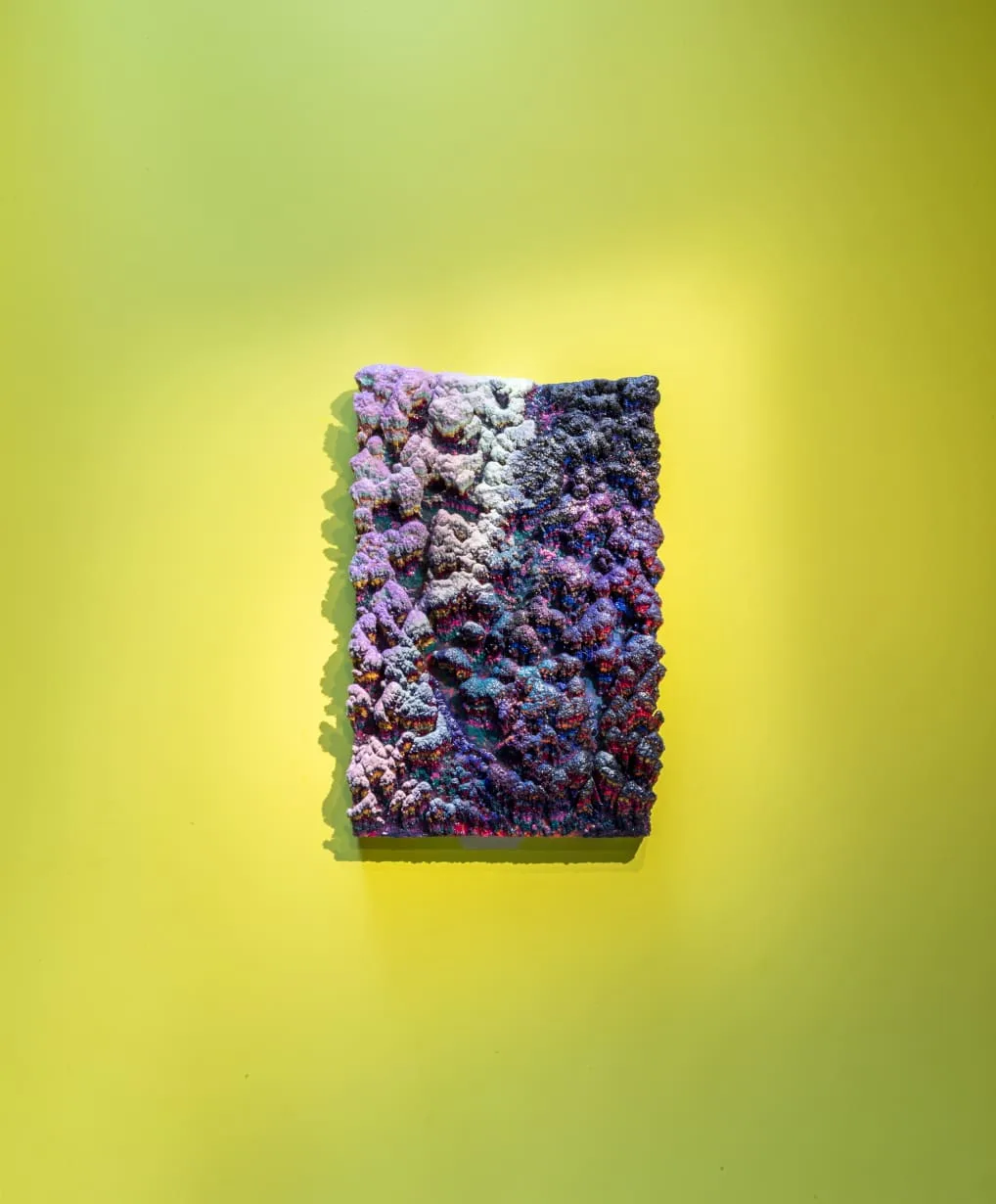“Kinesthesia is ones sense of their body in space. It is because of kinesthesia that we can walk in a room which is completely dark. Kinesthesia is the sum of the useful sensory information about our body in motion. My art is visual but the mental information I use to create this work comes from a kinesthetic sense, or feeling, about the work, rather than a visual or analysis of it.”
Colorado-based artist Dylan Gebbia-Richards, brings insight into his transcendent works in which the organic is appropriated by the artificial. Kinesthesia, marks Gebbia-Richards’ first solo-show with Unit London and in his words:
Kinesthesia is an instinct – there are no words which go into generating it – it is visceral. When we think of instinct we think of a cheetah chasing an antelope or something equally basal and related to the animal kingdoms. Instinct is how we connect with ourselves beyond just relating to the thoughts we have ABOUT ourselves. These paintings are my attempt to connect with that core – the soul element of who I am.
I believe that we most find ourselves when we forget who we are. It is in these moments of lapsing consciousness, decisions made outside of thought, that we get at the soul of something. An essence which cannot be summarized through rationale. An essence that is lived.
I learn through movement. I encode my thoughts in the muscles of my body. These works are kinesthetic. The word kinesthetic echos the word aesthetic. I like the idea of kinesthetic being not just a way of learning, but how something appears in space. A feeling, appearing as something tangible.
While working I deliberate to not deliberate. I work, so as to feel as though I am not working. We see the world and we also feel the world. I feel my environment through seeing. Both the canvas and wax works are made through call and response. Something is changed and then the next action is a response to that previous change, and the aggregate of all previous changes, and so on and so forth until the piece is complete.
Deeper into the process are the tools I use to make my works. The canvas pieces are very raw. I paint directly from the tube, fling pigment from the container and use my hands instead of brushes. To change colors I simple put on a new pair of gloves.
The wax paintings couldn’t be further than this. The process is extremely technical and complex. I use specialized tools and machines which have either been “hacked” and repurposed for my process , like the 100 lb wax melter , I use, – typically used for making candles, or they have been engineered from the ground up, like the actual brushes, or applicators I use. These applicators have been painstakingly created as the result of months of work in testing epoxy resins, calibrating temperature controls and adjusting the specific geometry of different parts of these machines, crucial to the final painting results.
Before making any of the encaustic works for this show, I spent about a month inventing and engineering a new tool for applying the pigment and wax to the panels. This implement has allowed me be much more specific with the colors I am applying, allowing for greater detail in both the physical topography of the work and the compositions of color within that topography. Before this new tool it was like I was trying to make small drawings with a spray can, now I have a pencil.
Gebbia-Richards’ works become landscapes – organic protrusions that seem to escape from the canvas. The artist embarks on a discovery of the physical manifestations of his scientific background. His geological creations, reminiscent of the landscape in Gebbia-Richards’ hometown, demand the space they inhabit in a similar way that agriculture might scale and dominate a building if left to its own devices.
Gebbia-Richards’ practice explores the synthesis and artificiality of human-made environments, and how colour and scale work alongside one another to captivate the viewer. The artist combines melted paraffin wax with pigments; by making his paints, Gebbia-Richards fabricates a sense of control over the otherwise erratic pieces. The unpredictability of his process ultimately wins the battle, rendering his pieces all the more intriguing as it mirrors our inability to control and dominate the elements. As chance takes over, Gebbia-Richards’ works viewers to lose themselves within an unmarked, chaos-ridden territory.
In the ever-growing turbulence of environmental concern, Gebbia-Richards’ use of colour and installation allude to themes of 1960s sci-fi resurgence and psychedelia – all of which appeal to societal cries for escapism. The vibrant colours are potently hallucinogenic, transporting viewers to alternate headspaces. Gebbia-Richards’ enthrallment with topography, paired with synesthesia creates a sense of endless continuation.
Gebbia-Richards intently observes the metamorphosis of the natural world around us. His practice enables viewers to peer into the intricacies and immensities of the landscapes we overlook. His works challenge audiences to at once seek and submit to its overwhelming prominence and to respect its immersive supremacy.
Dylan Gebbia-Richards
Dying of the Light
2019
Dylan Gebbia-Richards
Waving
2019
Dylan Gebbia-Richards
Sequence
2019
Dylan Gebbia-Richards
Earthly Delights
2019
Dylan Gebbia-Richards
Home in the Fire
2019
Dylan Gebbia-Richards
Glitches, Emotions
2019
Dylan Gebbia-Richards
Soulful Predator
2019
Dylan Gebbia-Richards
Ebb of Reason
2019
Dylan Gebbia-Richards
Phoenix
2018
Dylan Gebbia-Richards
Jester
2019
Dylan Gebbia-Richards
Omni
2018
Dylan Gebbia-Richards
Fall From Grace
2016
Dylan Gebbia-Richards
Above The Clouds
2018
Dylan Gebbia-Richards
Being an Animal
2019
Dylan Gebbia-Richards
Refracted
2018
Dylan Gebbia-Richards: Kinesthesia
Request an exhibition catalogue
Are U interested in learning more about the works in Dylan Gebbia-Richards’ new exhibition? Request a catalogue today…
exhibitions, artists and events.








